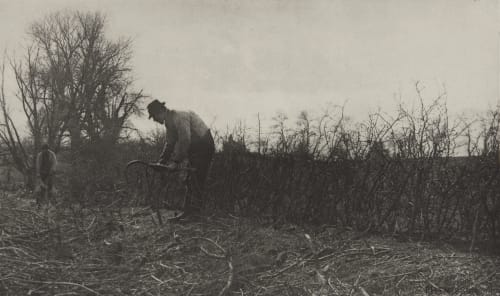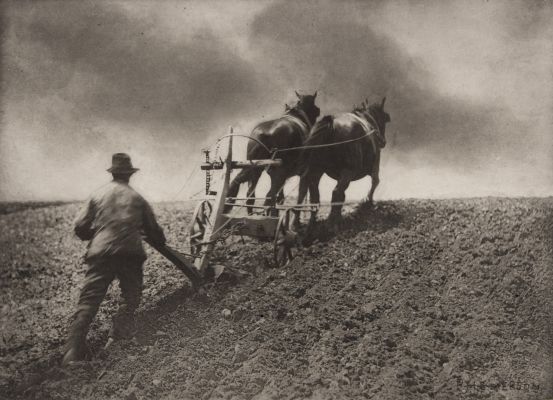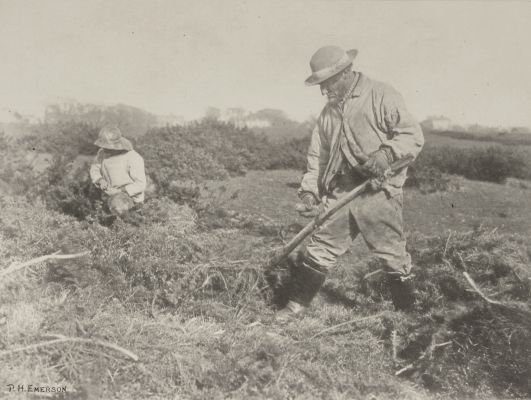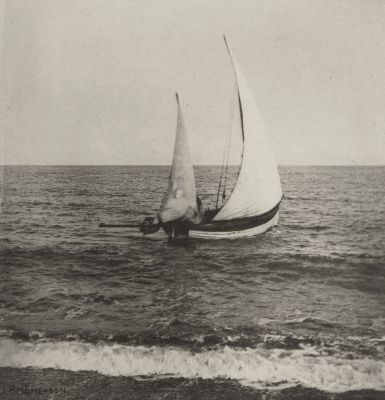
Title
Fencing in SuffolkArtist
Emerson, Peter Henry (British, 1856-1936)Key FigurePublication
Pictures of East Anglian LifeDate
1888Process
PhotogravureAtelier
Walter L. Colls, LondonImage Size
26.9 x 16.0 cm
Pictures of East Anglian Life is the largest and most ambitious of Emerson’s photographic books containing 32 photogravure plates. Pasted on the inside cover is a broadside “To the student” dated September 1889, keying the plates to Emerson’s treaty on photography as art, Naturalistic Photography. I have endeavoured in the plates to express sympathetically various phases of peasant and fisher folk life and landscape which have appealed to me in Nature by their sentiment or poetry. The volume cumulatively proposes that the essence of that life is hard work, as the title of the epic plowing scene A Stiff Pull indicates. In the Barley Harvest depicts a moment’s break in the agricultural labor and perfectly exemplifies Emerson’s principle of differential focus. [1] The deluxe edition was originally advertised as limited to seventy-five copies, but only twenty-five books and fifty portfolios were actually issued. An ordinary edition bound in half leather was originally advertised as limited to 500 copies, but only 250 copies were actually issued, some with the plate, Mending the Old Wherry substituted for A Way Across the Marshes which wore out after 30 pulls. In 1890, an additional 250 portfolios of the best photographs in the ordinary edition was also issued, but the plates had worn thin resulting in inferior prints. The reason Emerson gave for curtailing production is, “the plates were bad.” [2] The plates have been reproduced on Copper from my original negatives by the Autotype Company, the Typographic-Etching Company and Messrs. Walker & Boutall.” [3]
In 1889 Emerson published his controversial book Naturalistic Photography for Students of the Art without images. Naturalistic Photography examined his purist approach to photography, derived from his fascination with Naturalism in art, and attacked the prevailing artificial aesthetic in art photography. After its publication Emerson felt that his opponents had misunderstood his ideas. So, in 1890 he selected 10 plates from his book Pictures of East Anglian Life (1888) that best illustrated his theories, and presented them loose in a portfolio dedicated to the ‘photographic student’, with the same title and cover of the book. He then donated copies of this portfolio to every photographic society in the country.
References
[1] Foster, Sheila J. Imagining Paradise: The Richard and Ronay Menschel Library at George Eastman House, Rochester. Rochester, NY: George Eastman House, 2007.
[2] Kahan – UT Austin
[3] Préface. Folio, t.e.g. (viii) 150 (2) pp. with The Truthful Lens no. 52
Newhall, Nancy. P. H. Emerson: The Fight for Photography As a Fine Art. New York: Aperture, 1976. p. 189.
Carl Fuldner, ‘Emerson’s Evolution’ Tate Papers, no. 27, Spring 2017, http://www.tate.org.uk/research/publications/tate-papers/27/emersons-evolution, accessed 26 July 2017.
Taylor J. The Old Order and the New : P.H. Emerson and Photography 1885-1895. Munich: Prestel; 2006.











